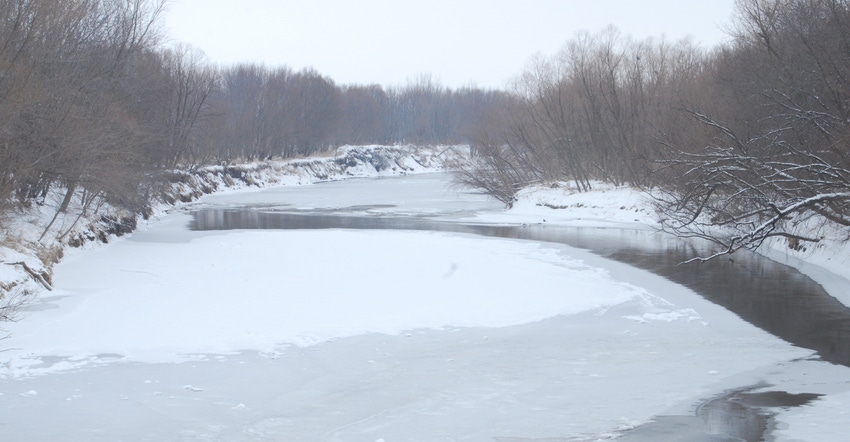March 14, 2019

The annual report measuring progress of the Iowa Nutrient Reduction Strategy in improving the state’s water quality was released in early March. It provides updates on efforts to reduce the amount of nitrogen and phosphorus leaving Iowa in the state’s rivers and streams. The report looks at both point source and nonpoint source efforts to reduce the levels of nitrogen and phosphorus in the water.
The report follows the “logic model” framework that identifies measurable indicators of desirable change that can be quantified. It measures the progression toward the Iowa NRS goals of achieving a 45% reduction in nitrogen and phosphorus levels in streams, rivers and lakes.
Iowa State University, the Iowa Department of Agriculture and Land Stewardship, and the Iowa Department of Natural Resources announced that the new Iowa Nutrient Reduction Strategy Annual Progress Report can be found at nutrientstrategy.iastate.edu/documents.
Report: Progress being made
“We are committed to robust measuring and reporting on each of the steps necessary to reach our state’s water quality goals,” says Mike Naig, Iowa secretary of agriculture. “This report shows progress in each of the areas measured. We are encouraged by the efforts of the public and private sectors to implement conservation practices across Iowa, and we are working to build on this success going forward.”
Bruce Trautman, acting director of the Iowa DNR, says, “The Nutrient Reduction Strategy is a very important and critical effort working to enhance water quality, and to see positive changes and results is gratifying. We are continually committed to improving and protecting water quality, and with partnerships developed through the INRS strategy, we are making great strides, but we still have work to do to meet the goals.”
The framework recognizes to affect change in water quality, there is a need for increased inputs such as funding, staff and resources. Inputs affect change in outreach efforts and human behavior, Naig says. With changes in human attitudes and behavior, changes on the land may occur, measured as conservation practice adoption and wastewater treatment facility upgrades. These physical changes on the land may affect change in water quality, which ultimately can be measured through both water quality monitoring and modeled estimates of nutrient loads in Iowa surface water.
“The report highlights the increase in activities in the five years since the Iowa Nutrient Reduction Strategy began, which is encouraging,” says Matt Helmers, director of the Iowa Nutrient Research Center at ISU. “But it’s also important to recognize the scale of change required to meet the nutrient reduction goals, and the need for increased levels of adoption and use of the practices needed throughout the state.”
Highlights from report
Inputs going into the Iowa NRS are defined as funding, staff and resources. Here’s what the new report says happened during the 2018 reporting period:
Funding. The report identified $512 million in private and public sector funding for Nutrient Reduction Strategy efforts. Long-term funding is now in place that will provide an additional $270 million for conservation practices and wastewater treatment upgrades over the next 12 years.
Iowa Nutrient Research Center. Since 2013, INRC has funded $8.7 million for 76 research projects at the state’s three regents universities. The research evaluates the performance of current and emerging nutrient management practices and provides recommendations on implementing the practices and developing new ones.
Treatment and industrial facilities. Of the 154 municipal wastewater treatment plants and industrial facilities that are required to assess their nutrient removal capacity, 125 have been issued new permits and 82 of those have submitted feasibility studies on potential technology improvements to reduce nutrient loss.
Conservation Infrastructure Initiative. The initiative engaged a broad cross-section of leaders within and outside of the ag industry. They addressed barriers, innovative market-based solutions and new revenue streams to improve water quality.
Outreach. Partners reported 511 outreach events focused on water quality were held in 92 counties. The partners also reported 45,800 participants attended an outreach event.
Cover crops and CRP. Statewide estimates find 760,000 acres of cover crops were planted in 2017, including 330,000 acres enrolled in government cost-share programs. A total of 1.8 million acres were enrolled in the USDA Conservation Reserve Program, about 200,000 more acres than in 2011.
Value of conservation. Statewide mapping of six types of conservation practices found the value of public and private investment in conservation would be $6.2 billion in today’s dollars. Additional analysis will quantify the water quality impact of these practices in terms of reduced sediment and phosphorus loads to Iowa streams.
Water quality monitoring
Iowa has an extensive water quality monitoring system in place, including 32 more real-time nitrate sensors deployed by the University of Iowa’s Hydroscience and Engineering IIHR than in 2016. Originally, IIHR stood for the Iowa Institute of Hydraulic Research. In 2002, this name was officially changed to IIHR — Hydroscience & Engineering to better reflect the broad scope and modern multidisciplinary nature of the institute’s focus. The acronym “IIHR” has been retained to reflect the institute’s history and achievements.
At least 88% of Iowa’s land drains to a location with water quality sensors installed and maintained. They are maintained mainly by the Iowa Department of Natural Resources, the Hydroscience and Engineering IIHR, and the U.S. Geological Survey.
Surface water samples are collected regularly at 302 locations in Iowa. Also, 582 edge-of-field sites are sampled regularly by the Iowa Soybean Association and Agriculture’s Clean Water Alliance.
“The annual report works toward evaluating progress using an updated baseline that is consistent with the Gulf of Mexico Hypoxia Task Force and follows the direction of the Iowa Legislature,” Naig says. “The baseline looks at the 1980-96 time period. In future reports, the baseline period will be used to measure progress towards water quality goals identified by the Iowa Nutrient Reduction Strategy.”
About the Author(s)
You May Also Like






